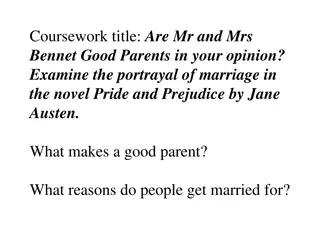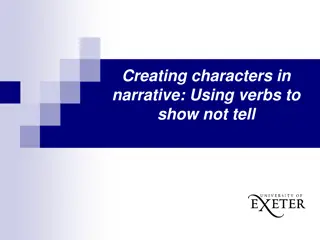Analysis of Narrative Techniques and Character Development in Pride and Prejudice
Jane Austen's novel, Pride and Prejudice, employs a third-person omniscient narrator to provide insights into character perspectives, particularly focusing on Elizabeth Bennet. The narrative techniques reveal different viewpoints and character depths, while the character analysis of Mr. Bennet showcases a complex figure with a mix of humor, sarcasm, and apathy, impacting the dynamics within the Bennet family.
Download Presentation

Please find below an Image/Link to download the presentation.
The content on the website is provided AS IS for your information and personal use only. It may not be sold, licensed, or shared on other websites without obtaining consent from the author.If you encounter any issues during the download, it is possible that the publisher has removed the file from their server.
You are allowed to download the files provided on this website for personal or commercial use, subject to the condition that they are used lawfully. All files are the property of their respective owners.
The content on the website is provided AS IS for your information and personal use only. It may not be sold, licensed, or shared on other websites without obtaining consent from the author.
E N D
Presentation Transcript
Narrative techniques Jane Austen s novel Pride and Prejudice is constructed with a third-person omniscient narrator, as we often see in old novels. This is seen by the fact that the narrator is outside the plot and knows about the thoughts and feelings of all characters, which means we have multiple points of view in this story. However, although we get to see different points of view, the narrator mostly follows the point of view of Elizabeth Bennet. Very often, throughout the novel, we know what Elizabeth is thinking and how she perceives different events. Here is one example:
Narrative techniques Elizabeth took up some needlework and was sufficiently amused in attending to what passed between Darcy and his companion. The perpetual commendations of the lady either on his handwriting, or on the evenness of his lines, or on the length of his letter, with the perfect unconcern with which her praises were received, formed a curious dialogue, and was exactly in unison with her opinion of each. (p. 32) As mentioned, an omniscient narrator can theoretically access the minds of all characters, which we see in this passage where we get to go inside Darcy head: Darcy had at first scarcely allowed her to be pretty; he had looked at her without admiration at the ball; and when they next met, he looked at her only to criticize. But no sooner had he made it clear to himself and his friends that she hardly had a good feature in her face, than he began to find it was rendered uncommonly intelligent by the beautiful expression
Pride and Prejudice Character Analysis: Mr. Bennet How Austen depicts Mr. Bennet. Is he a positive or negative figure? Written with wit and humor, Austen s highly acclaimed Pride and Prejudice allures readers as it journeys through an enticing narrative of love despite whatever external and internal conflicts arise. The story revolves around Elizabeth Bennet, whose social status leads her mother to desperately find wealthy suitors for her and her sisters to marry. On the other hand, there is Elizabeth s father, Mr. Bennet, whose character development would either surprise you or displease you. Austen portrays Mr. Bennet as a humorous but sarcastic man who is exasperated with the hopelessness of his family. Nevertheless, Mr. Bennet still has this strong connection with his favorite daughter Elizabeth, whom he can talk to with ease and satisfaction due to their mutual intelligence and understanding. Having seen him as one of the closest family members to Elizabeth who understands her, the reader would immediately empathize with him. However, as the story progresses, Mr. Bennet becomes lazy and apathetic, a characteristic that supposedly a patriarch should not possess. On the surface it might look less harmful than drinking and gambling, but it s just as destructive to his family (Shmoop Editorial Team). Several circumstances arise in the family, but Mr. Bennet does nothing about it. He sympathizes with his family s problems; however, he prefers to hide in his library instead of standing up and facing problems. When faced with choices, he would typically choose the path of least resistance, without consideration of the consequences (Mortensen).
Pride and Prejudice Character Analysis: Mr. Bennet How Austen depicts Mr. Bennet. Is he a positive or negative figure? Therefore, Austen depicts Mr. Bennet as a negative character, one who does not care about his family s future nor his daughters present situation. Instead of helping his family, he often mocks them with his jokes. He is a coward who fails to become a source of strength to the family. Mr. Bennet would rather escape the world than cope with it ( Mr. Bennet ). Pride and Prejudice is a well-known novel written by Jane Austen at the beginning of the 19th century. This book frequently becomes a topic of literary discussions, as it is considered a classic of English literature. If you have to compose a Pride and Prejudice essay, our sample may become a great starting point for you. This argumentative essay is provided by one of our well-educated writers. You can get a similar paper for your personal use if you place an order on our website, but you can t use this text for your homework without using proper citation. This Pride and Prejudice analysis isn t the only sample on our site worth your attention. You re welcome to pick a discipline that you re interested in and check out our samples. If you don t find an example on a specific topic, you can place an order at any time. Fill in the ordering form and let professionals deal with your homework!
SETTING The novel is set in the 19th century in England. It is set principally in Longbourn, the Hertfordshire country town that is a mile from Meryton and twenty-four miles from London. It is a well-ordered, provincial town, filled with landed gentry and oblivious to the sweeping changes occurring outside the fringes of its narrow, circumscribed vision.
SETTING Time setting The novel Pride and Prejudice by Jane Austen is set in Regency England, and the plot develops over the course of almost two years. The Regency Era is generally considered to refer to the period 1811-1820. The time setting is approximately contemporary with the time of publication, as the novel was published in 1813. Physicalsetting Jane Austen does not devote many descriptions to the physical setting. Although the events happen in a variety of places, these places are rarely described, the main exception being Mr Darcy s estate, Pemberley, where the physical setting takes on a particular significance. Austen even makes a direct note on her choice, emphasising the significance of one of the few places she does describe: It is not the object of this work to give a description of Derbyshire, nor of any of the remarkable places through which their route thither lay; Oxford, Blenheim, Warwick, Kenilworth, Birmingham, etc. are sufficiently known. A small part of Derbyshire is all the present concern. (p. 167) Through this observation, the author suggests that, from Elizabeth's trip, only Pemberley is important because of what it reveals about the male protagonist, Mr Darcy. The physical setting includes references to both real places in England and imaginary ones. London, Hertfordshire, Brighton, and Derbyshire are real places in the UK. However, the estates and other towns mentioned are fictional: Longbourn, Netherfield, Meryton, Pemberley...
CHARACTER LIST Major Characters Mrs. Bennet The match-making mother of five daughters. The wife of Mr. Bennet and "a woman of mean understanding, little information, and uncertain temper," who embarrasses her older daughters with her lack of class and entertains her husband with her ignorance. Mr. Bennet A country gentleman, who is the sometimes irresponsible father of five daughters and the husband of Mrs. Bennet. He is fond of books and can be witty and amusing. Jane Bennet The eldest daughter of the Bennets who is pretty, shy, calm, gentle and good-natured; she falls in love with and marries Mr. Bingley. Elizabeth Bennet (Lizzy) The second daughter of the Bennets who is lively, intelligent, witty and sensible; she at first strongly dislikes Mr. Darcy and then falls in love with him. Marry Bennet The third daughter, who is pedantic, tasteless, plain, vain, silly, and affected. Catherine Bennet (Kitty) The fourth daughter, who is almost a non-entity in the novel except for chasing soldiers. Lydia Bennet The youngest daughter who is silly, thoughtless, stupid, unprincipled, flirtatious, loud-mouthed and scatter brained; not surprisingly, she is Mrs. Bennet s favorite daughter. She elopes with George Wickham A handsome, militia officer Rev. Mr. Collins Mr. Bennet s cousin who is to inherit Mr. Bennet s property. He is a pompous, undignified mixture of servility and self- importance. Charles Bingley A wealthy country gentleman who is kind and charming. He falls in love with and marries Jane Bennett and is Darcy s best friend.
CHARACTER LIST Major Characters Fitzwilliam Darcy The wealthy, best friend of Charles Bingley who at first is proud, rude, and unpleasant; after falling in love with Elizabeth, he is shown to be discreet, shrewd, generous, and magnanimous; in the end, he wins Elizabeth s love. Minor Characters Georgiana Darcy The younger sister of Fitzwilliam Darcy who is shy, reserved, and warm-hearted. Mrs. Reynolds The trusted housekeeper of Mr. Darcy. Colonel Fitzwilliam The cousin of Mr. Darcy who is handsome and well-mannered. Lady Catherine de Bourgh Mr. Darcy s aunt who is arrogant, over-bearing, domineering, interfering, vulgar and affected; she cannot tolerate any opposition. Ann de Bourgh Lady Catherine s daughter who is sickly and coddled by her mother and who has no mind of her own. Mrs. Jenkinson Ann de Bourgh s teacher. Caroline Bingley Mr. Bingley s unmarried sister, who is snobbish, conceited, scheming and jealous. Mrs. Hurst Bingley s married sister who lives a lazy, purposeless life. Mr. Hurst Bingley s brother-in-law, who is lazy and purposeless, like his wife. George Wickham A seemingly charming man with attractive manners, who is really selfish, unprincipled, extravagant and prone to gambling; he is the villain of the novel, who elopes with Lydia Bennet Sir William and Lady Lucas Neighbors and friends of the Bennet family and parents of Charlotte. Charlotte Lucas The eldest daughter in the Lucas family who is plain, practical, intelligent and absolutely unromantic; she is a very close friend of Elizabeth. Mr. and Mrs. Gardiner Mrs. Bennet s brother and his wife who are sensible and refined; Mrs. Gardiner is a confidante of Jane and Elizabeth Bennet. Mrs. Philips Mrs. Bennet s sister, who is as vulgar and ridiculous as her sister; her husband is an attorney. Mary King an acquaintance of the Bennet family.























